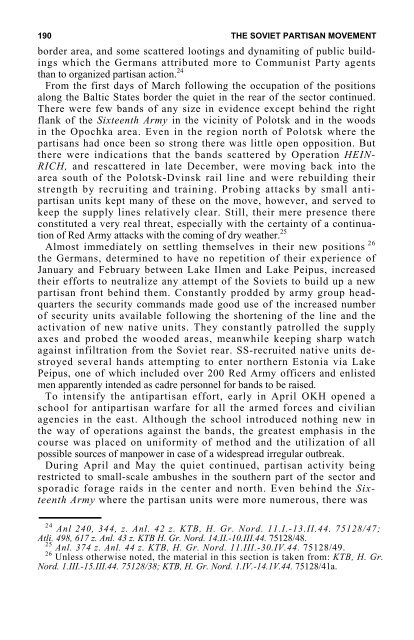the soviet partisan movement 1941-1944 by edgar m. howell
the soviet partisan movement 1941-1944 by edgar m. howell
the soviet partisan movement 1941-1944 by edgar m. howell
Create successful ePaper yourself
Turn your PDF publications into a flip-book with our unique Google optimized e-Paper software.
190 THE SOVIET PARTISAN MOVEMENT<br />
border area, and some scattered lootings and dynamiting of public buildings<br />
which <strong>the</strong> Germans attributed more to Communist Party agents<br />
than to organized <strong>partisan</strong> action. 24<br />
From <strong>the</strong> first days of March following <strong>the</strong> occupation of <strong>the</strong> positions<br />
along <strong>the</strong> Baltic States border <strong>the</strong> quiet in <strong>the</strong> rear of <strong>the</strong> sector continued.<br />
There were few bands of any size in evidence except behind <strong>the</strong> right<br />
flank of <strong>the</strong> Sixteenth Army in <strong>the</strong> vicinity of Polotsk and in <strong>the</strong> woods<br />
in <strong>the</strong> Opochka area. Even in <strong>the</strong> region north of Polotsk where <strong>the</strong><br />
<strong>partisan</strong>s had once been so strong <strong>the</strong>re was little open opposition. But<br />
<strong>the</strong>re were indications that <strong>the</strong> bands scattered <strong>by</strong> Operation HEIN-<br />
RICH, and rescattered in late December, were moving back into <strong>the</strong><br />
area south of <strong>the</strong> Polotsk-Dvinsk rail line and were rebuilding <strong>the</strong>ir<br />
strength <strong>by</strong> recruiting and training. Probing attacks <strong>by</strong> small anti<strong>partisan</strong><br />
units kept many of <strong>the</strong>se on <strong>the</strong> move, however, and served to<br />
keep <strong>the</strong> supply lines relatively clear. Still, <strong>the</strong>ir mere presence <strong>the</strong>re<br />
constituted a very real threat, especially with <strong>the</strong> certainty of a continuation<br />
of Red Army attacks with <strong>the</strong> coming of dry wea<strong>the</strong>r. 25<br />
Almost immediately on settling <strong>the</strong>mselves in <strong>the</strong>ir new positions 26<br />
<strong>the</strong> Germans, determined to have no repetition of <strong>the</strong>ir experience of<br />
January and February between Lake Ilmen and Lake Peipus, increased<br />
<strong>the</strong>ir efforts to neutralize any attempt of <strong>the</strong> Soviets to build up a new<br />
<strong>partisan</strong> front behind <strong>the</strong>m. Constantly prodded <strong>by</strong> army group headquarters<br />
<strong>the</strong> security commands made good use of <strong>the</strong> increased number<br />
of security units available following <strong>the</strong> shortening of <strong>the</strong> line and <strong>the</strong><br />
activation of new native units. They constantly patrolled <strong>the</strong> supply<br />
axes and probed <strong>the</strong> wooded areas, meanwhile keeping sharp watch<br />
against infiltration from <strong>the</strong> Soviet rear. SS-recruited native units destroyed<br />
several hands attempting to enter nor<strong>the</strong>rn Estonia via Lake<br />
Peipus, one of which included over 200 Red Army officers and enlisted<br />
men apparently intended as cadre personnel for bands to be raised.<br />
To intensify <strong>the</strong> anti<strong>partisan</strong> effort, early in April OKH opened a<br />
school for anti<strong>partisan</strong> warfare for all <strong>the</strong> armed forces and civilian<br />
agencies in <strong>the</strong> east. Although <strong>the</strong> school introduced nothing new in<br />
<strong>the</strong> way of operations against <strong>the</strong> bands, <strong>the</strong> greatest emphasis in <strong>the</strong><br />
course was placed on uniformity of method and <strong>the</strong> utilization of all<br />
possible sources of manpower in case of a widespread irregular outbreak.<br />
During April and May <strong>the</strong> quiet continued, <strong>partisan</strong> activity being<br />
restricted to small-scale ambushes in <strong>the</strong> sou<strong>the</strong>rn part of <strong>the</strong> sector and<br />
sporadic forage raids in <strong>the</strong> center and north. Even behind <strong>the</strong> Sixteenth<br />
Army where <strong>the</strong> <strong>partisan</strong> units were more numerous, <strong>the</strong>re was<br />
24 Anl 240, 344, z. Anl. 42 z. KTB, H. Gr. Nord. 11.I.-13.II.44. 75128/47;<br />
Atli. 498, 617 z. Anl. 43 z. KTB H. Gr. Nord. 14.II.-10.III.44. 75128/48.<br />
25 Anl. 374 z. Anl. 44 z. KTB, H. Gr. Nord. 11.III.-30.IV.44. 75128/49.<br />
26<br />
Unless o<strong>the</strong>rwise noted, <strong>the</strong> material in this section is taken from: KTB, H. Gr.<br />
Nord. 1.III.-15.III.44. 75128/38; KTB, H. Gr. Nord. 1.IV.-14.1V.44. 75128/41a.
















